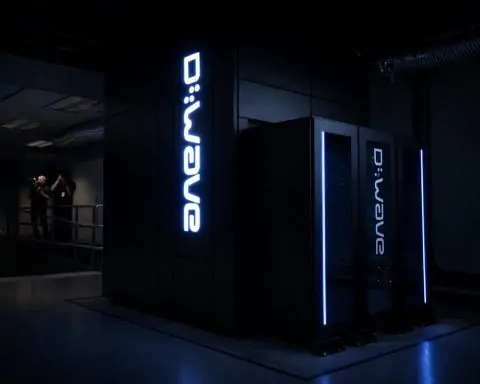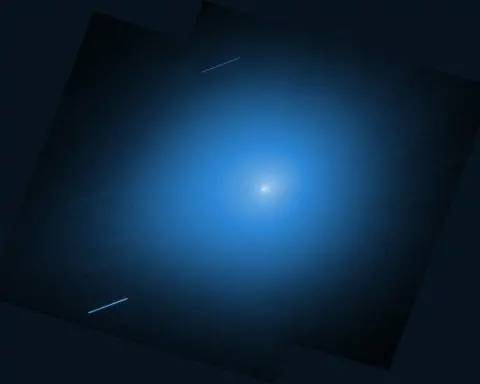- Boeing secured a $2.8 billion contract to develop next‑generation nuclear communications satellites for the U.S. military.
- Spanish operator Hisdesat completed two satellites in orbit and signed for two more in 2025, backed by Indra, targeting €1 billion in space revenue by 2030.
- SpainSat NG II, developed by Hisdesat and Airbus, is set to launch October 22–29 with NATO as its first client for both military and civil applications.
- SpaceX’s Starlink now accounts for more than 60% of all active satellites, following launches including Starlink 10-28 from Cape Canaveral and a Vandenberg mission delivering 70 small satellites.
- SpaceX plans a 40-antenna satellite communications facility in Manatee County, Florida, with an estimated $1.8 billion investment and 600 jobs by 2030 to support Starlink.
- Sateliot has commissioned five Alén Space satellites to expand its global 5G NB-IoT network and is preparing for commercial service launches in Brazil, aiming for more than 100 satellites total.
- ESA’s Proba‑3 mission delivered the first artificial solar eclipse using two formation-flying spacecraft for hours-long corona observations.
- Russia’s Kondor-FKA Arctic monitoring system features two satellites with up to one-meter resolution and is being expanded with Kondor-FKA No.3 and No.4.
- NASA’s Relay 2, inactive since 1967, emitted a nanosecond energy burst detected by ASKAP, highlighting the ongoing issue of space debris and end-of-life phenomena.
- NASA’s James Webb Telescope observations suggest exoplanet TWA 7b, about 100 times Earth’s mass and 47°C, orbiting the star TWA 7 and potentially revealing a Trojan disk.
Space News Today: Global Advances, Challenges, and New Frontiers
The space sector is experiencing a period of unprecedented dynamism, with breakthroughs in satellite technology, rocket launches, scientific discoveries, and international collaborations. This comprehensive roundup distills the most significant developments from the latest news, spanning military and commercial satellite deployments, advances in space science, environmental concerns, and the evolving landscape of space policy and industry.
Military and Secure Communications: New Contracts and Strategic Assets
Boeing’s $2.8 Billion Nuclear Communications Satellite Contract
Boeing has secured a $2.8 billion contract to develop next-generation nuclear communications satellites for the U.S. military, reinforcing its pivotal role in secure defense communications. This investment underscores the ongoing prioritization of resilient, survivable satellite infrastructure to ensure command and control continuity in extreme scenarios, including nuclear conflict.- Key Points:
- Contract value: $2.8 billion.
- Focus: Next-gen secure nuclear communications.
- Significance: Bolsters U.S. national security and defense satellite capabilities.
Spain’s Hisdesat: A European Satellite Powerhouse
Spanish operator Hisdesat has marked a triumphant year, with two satellites launched and two more under contract for 2025, securing its commercial future through 2040. Backed by Indra, Hisdesat is targeting €1 billion in space revenue by 2030 and aims to become a European leader in secure communications and Earth observation.- Key Points:
- Two satellites launched, two more contracted for 2025.
- Focus: Secure communications and Earth observation.
- Ambition: European leadership and €1 billion revenue by 2030.
SpainSat NG II: NATO’s New Military Satellite
The SpainSat NG II satellite, developed by Hisdesat and Airbus, is set for launch between October 22-29, with NATO as its first client. The satellite will support both military and civil applications, enhancing secure communications for allied operations.[4]Commercial Satellite Internet: Starlink, Kuiper, and Global Connectivity
SpaceX Starlink: Launches, Expansion, and Emergency Response
SpaceX continues its rapid Starlink deployment, with multiple Falcon 9 launches scheduled from Cape Canaveral and Vandenberg. The Starlink constellation now constitutes over 60% of all active satellites, providing global broadband and emergency connectivity.- Recent Launches:
- Starlink 10-28 mission from Cape Canaveral.
- Vandenberg launch delivering 70 small satellites for customers.
- Emergency Response:
- Starlink and T-Mobile enabled satellite SMS and free internet for flood-affected Texas, distributing Mini kits to rescue teams and offering a month of free service.
- Technical Expansion:
- SpaceX filed plans for a 40-antenna satellite communications facility in Manatee County, Florida, supporting Starlink’s global ambitions and promising $1.8 billion in investment and 600 jobs by 2030.
- Device Compatibility:
- Starlink’s free satellite texting and location sharing will soon be available on a wide range of smartphones, including iPhone 14+, Samsung Galaxy A14-A54 & S21+, Google Pixel 9/9 Pro, and 2024+ Motorola models.
- T-Mobile’s T-Satellite service will extend Starlink connectivity to older phones, including the iPhone 13, starting July 23.
- Rail Connectivity:
- France’s SNCF is considering Starlink and Eutelsat/OneWeb to improve unreliable Wi-Fi on TGV trains, with technical validation underway.
Amazon’s Project Kuiper: Race to Market
Amazon’s Project Kuiper is accelerating, with 54 satellites launched and a target of 3,232 satellites by July 2026. The company aims to offer operational satellite internet by the end of this year, intensifying competition with Starlink.[13]Sateliot: 5G IoT Satellite Constellation
Sateliot is expanding its 5G NB-IoT satellite constellation, commissioning five new satellites from Alén Space and preparing for commercial service launches in Brazil. The network aims to integrate satellite and terrestrial 5G, targeting sectors like agriculture and mining.[14] | [15]Kacific and Pak Datacom: Rural Broadband in Pakistan
Kacific and Pak Datacom have signed an MoU to deliver satellite broadband across rural Pakistan, leveraging high-throughput satellites for underserved communities, especially in education and healthcare.[16]Satellite Technology: Innovation, Science, and Industry
AI-Powered Satellites and Digital Twins
UC Davis researchers have launched the first satellite with an onboard AI-powered digital twin, capable of monitoring and predicting its own health in real time. This innovation marks a leap toward autonomous, self-healing spacecraft.[17]Mini4EO: Spanish Earth Observation and Signal Surveillance
Indra is developing the Mini4EO satellite constellation for Earth observation and electronic signal surveillance, with the first launch planned for 2026. The project aims to serve both civil and military applications.[18]Harbin’s Space Technology Leadership
Harbin, China, has launched eight ‘Gongda’ satellites and operates a ground space station supporting over a thousand tests for biobreeding and commercial satellites, reinforcing its role in national science and innovation.[19]Russia’s Kondor-FKA: Arctic Monitoring
Russia has commissioned the Kondor-FKA satellite system, featuring two satellites with up to one-meter resolution for 24/7 Earth observation, focusing on the Arctic and Northern Sea Route. Expansion is underway with Kondor-FKA No.3 and No.4.[20]China’s Zhangheng-1 02: Geophysical Field Detection
China launched its first geophysical field detection satellite, Zhangheng-1 02, enhancing disaster monitoring and real-time electromagnetic field observation.[21]Bahrain’s Dhawan 1: Regional Space Cooperation
Bahrain, in partnership with the UAE, has launched its first satellite, Dhawan 1, marking a milestone in regional space ambitions and collaboration.[22]Space Science: Cosmic Mysteries and Planetary Discoveries
The Universe’s Missing Baryonic Matter Found
Scientists have finally located the universe’s missing baryonic matter using Fast Radio Bursts (FRBs), detecting it in the intergalactic medium. This breakthrough enhances our understanding of the cosmic web and galaxy evolution.[23]23 Million Light-Year-Long Gas Filament Discovered
NASA and international astronomers have discovered a 23 million light-year-long gas filament at 10 million °C, helping explain the universe’s missing matter and advancing knowledge of the cosmic web.[24]Dark Energy: Is Cosmic Expansion Slowing?
New data from the South Pole Telescope and DESI suggest that dark energy may be weakening, challenging the standard Lambda-CDM model. Some models predict the universe could begin contracting in 7 billion years, leading to a “Big Crunch” in about 33.3 billion years.[25] | [26] | [27]The Ongoing Search for Planet Nine
The mystery of Planet Nine persists, blending ancient myth with modern astronomy. Recent infrared surveys using IRAS and AKARI have identified two candidates for Planet Nine based on their thermal signatures, but confirmation is pending.[28] | [29] | [30]Exoplanet Discovery: TWA 7b
NASA’s James Webb Telescope has detected a possible exoplanet, TWA 7b, 100 times Earth’s mass and 47°C, orbiting the young star TWA 7. This may be the first direct evidence of a Trojan disk, offering insights into planet formation.[31]Earth and Planetary Science: Mars, Venus, and Weather Satellites
Mars: Water Loss and Perseverance’s Discoveries
A University of Chicago-led study suggests Mars experienced brief warm periods due to solar brightening but reverted to a cold, dry state, explaining its transition from a river-rich planet to a barren desert. NASA’s Perseverance rover, using lasers and gas blasts, has uncovered water-rich clay, feldspar, and a rare mineral in a stubborn Mars rock, offering new clues about the planet’s past.[32] | [33]Venus: Earth Weather Satellites Unlock Secrets
Japan’s Himawari-8 and -9 weather satellites are now used to monitor Venus’ cloud-top temperatures over time, enabling continuous, multi-year atmospheric observations previously impossible with planetary missions.[34]Sentinel-4 and MTG-S1: Air Quality and Severe Weather
Europe’s Sentinel-4 satellite, launched July 1, provides hourly, high-resolution air quality scans, tracking pollutants like NO₂, O₃, and SO₂. The new MTG-S1 satellite enhances early warnings for severe weather, collecting unique atmospheric data for improved forecasting.[35] | [36]Space Operations: Launches, Reusability, and Environmental Concerns
ArianeGroup and ESA: Prometheus and Themis
ArianeGroup has completed key test ignitions of the reusable Prometheus rocket engine, a major step for European space technology. The Themis reusable rocket stage is ready for shipment to Esrange Space Centre in Sweden, featuring advanced tech like landing legs and grid fins.[37] | [38]SpaceX Starship: Explosions and Environmental Impact
A recent SpaceX Starship test flight ended in an explosion, scattering debris into the Indian Ocean and onto Mexican beaches, raising environmental concerns—especially for endangered sea turtles. SpaceX denies any chemical, biological, or toxicological risk and is collaborating with Mexican authorities on debris recovery.[39] | [40] | [41]Space Security and Geopolitics
Russian ‘Matryoshka’ Satellites and ASAT Concerns
Russian satellite Kosmos-2558 deployed a subsatellite near the US reconnaissance satellite USA 326, raising alarms over possible anti-satellite (ASAT) capabilities. NASA and US Space Command are closely monitoring, warning of escalating space arms race risks and the need for updated international regulations.[42] | [43]Human Spaceflight: International Collaboration and Outreach
Axiom Space Ax-4: Poland and Hungary Return to Space
Hungary and Poland have returned to human spaceflight after over 40 years, with astronauts Slawosz Uznanski and Tibor Kapu joining Axiom Space’s Ax-4 mission to the ISS. The mission, commanded by Peggy Whitson, includes international science experiments and marks renewed Central and Eastern European participation.[44] | [45] | [46]NASA and Netflix: ISS Live Broadcasts
NASA and Netflix are partnering to stream live ISS events, including launches and spacewalks, to Netflix’s 270 million users, expanding public engagement with space exploration.[47]Satellite Industry and Market Trends
Satellite ETFs: Market Performance and Caution
- Satellite ETF (159206): Down 1.00% with a turnover of 5.17 million yuan. Major holdings: China Telecom, ZTE, China Satellite.
- Satellite Industry ETF (159218): Down 0.09% with a turnover of 1.98 million yuan. Major holdings: China Satellite, China Satcom, Beidou Xingtong.
Space Debris and Satellite Longevity
NASA’s Relay 2: Energy Burst After 60 Years
NASA’s long-defunct Relay 2 satellite, inactive since 1967, shocked astronomers by emitting a powerful, nanosecond-long energy burst detected by ASKAP. The event, possibly caused by a collision or electrostatic discharge, highlights the need for monitoring space debris and understanding satellite end-of-life phenomena.[50] | [51] | [52]Space Calendar and Skywatching
2025: A Year of Launches and Celestial Events
2025 promises a packed calendar of rocket launches, space missions, and skywatching events. Highlights include Roscosmos’ Progress MS-31 ISS resupply, multiple SpaceX Starlink launches, and the Full Buck Moon on July 10, which will appear unusually low and may glow orange-red.[53] | [54]Outlook: The Road Ahead
Key Takeaways
- Satellite proliferation is transforming communications, science, and defense, but also raising concerns about orbital crowding and debris.
- International collaboration is driving new missions, from ISS science to regional satellite launches.
- Environmental and security challenges—from rocket debris to anti-satellite weapons—demand urgent regulatory and technological responses.
- Scientific discoveries are reshaping our understanding of the universe, from missing matter to the fate of cosmic expansion.
- Commercial competition (Starlink, Kuiper, Sateliot) is accelerating global broadband access and technological innovation.
What to Watch
- SpaceX and Amazon’s satellite internet race: Who will dominate global broadband?
- Regulatory responses to space debris and ASAT threats.
- New scientific missions: Will we confirm Planet Nine? Will dark energy’s secrets be unlocked?
- Human spaceflight: Expansion of private missions and international partnerships.
- Environmental stewardship: How will the industry address rocket debris and its impact on Earth’s ecosystems?
Stay tuned for more updates as the space sector continues to redefine the boundaries of technology, science, and human ambition.
More today’s sources
Boeing Secures $2.8 Billion Contract for Next-Gen Nuclear Communications Satellites
Boeing has landed a $2.8 billion deal to build next-generation nuclear communications satellites, strengthening its role in secure military satellite communications. This contract highlights the ongoing investment in advanced satellite technology for national security and defense.
Continue reading on [55]
Hisdesat Achieves Milestone: Two Satellites in Orbit, Two More Contracted for 2025
Spanish operator Hisdesat celebrates a triumphant year with two satellites launched and two more under contract for 2025, securing its commercial future to 2040. Indra aims to make Hisdesat a leader in European space, targeting €1 billion in space revenue by 2030. “Very enthusiastic” about enhanced services, say Hisdesat executives.
Continue reading on [56]
SpaceX Starlink Launch: Falcon 9 to Deploy Satellites from Cape Canaveral
SpaceX is set to launch a Falcon 9 rocket from Cape Canaveral, Florida, during a window from 1:48 a.m. to 6:18 a.m. The mission, Starlink 10-28, will deploy a batch of Starlink communications satellites into low-Earth orbit. The first-stage booster will attempt a drone ship landing at sea.
Continue reading on [57]
Dead NASA Relay 2 Satellite Emits Powerful Energy Burst After Decades
NASA’s Relay 2 satellite, inactive since 1967, shocked astronomers by emitting a powerful, nanosecond-long energy burst detected by ASKAP. Researchers suspect a collision or electrostatic discharge caused the event. Clancy James called the pulse “incredibly powerful,” and Karen Aplin noted this detection could help evaluate electrostatic discharges in space debris.
Continue reading on [58]
Dead NASA Relay 2 Satellite Emits Powerful Energy Burst After Decades
NASA’s long-defunct Relay 2 satellite shocked astronomers by emitting a powerful, nanosecond-long radio pulse nearly 60 years after deactivation. Researchers suggest a collision or electrostatic discharge as possible causes. Astrophysicist Karen Aplin noted, “this radio detection may ultimately offer a new technique to evaluate electrostatic discharges in space.”
Continue reading on [59]
Scientists Discover Universe’s Missing Baryonic Matter in Intergalactic Medium
Scientists have finally located the universe’s missing baryonic matter, solving a decades-old mystery. Using Fast Radio Bursts (FRBs), researchers detected this matter in the intergalactic medium, a vast network of hot, diffuse gas between galaxies. This breakthrough enhances our understanding of the cosmic web and galaxy evolution.
Continue reading on [60]
Hisdesat Achieves Major Milestones: Two Satellites Launched, Two More Contracted for 2025
Spanish satellite operator Hisdesat celebrates a successful year with two satellites in orbit and two more under contract for 2025. Backed by Indra, Hisdesat aims to strengthen Spain’s role in the European space industry, focusing on secure communications and Earth observation for government and institutional clients.
Continue reading on [61]
SpaceX Plans Satellite Communications Facility in Manatee County, Florida
SpaceX has filed plans for a satellite communications facility in Myakka City, Manatee County, featuring 40 antennas for uplink and downlink services. The site supports the Starlink initiative, aiming to deliver high-speed internet globally. SpaceX’s Florida expansion could bring $1.8 billion in investment and 600 jobs by 2030.
Continue reading on [62]
Sateliot Commissions Five Satellites from Alén Space to Expand Global 5G Network
Sateliot has commissioned five new satellites from Alén Space to enhance its global 5G satellite network. This move aims to improve connectivity and expand coverage, supporting the integration of satellite and terrestrial 5G services worldwide.
Continue reading on [63]
Starlink and T-Mobile Enable Satellite SMS and Free Connectivity for Flooded Texas Areas
Starlink and T-Mobile have activated satellite SMS and provided free internet for flood-affected Texas regions. Starlink distributed Mini kits to rescue teams and offered a month of free service to users. T-Mobile customers can send SMS via Direct to Cell satellites in impacted counties, ensuring emergency communication where traditional networks failed.
Continue reading on [64]
ESA’s Proba-3 Satellite Achieves First Artificial Solar Eclipse
The European Space Agency’s Proba-3 mission has delivered its first artificial solar eclipse using two spacecraft in precise formation. This allows daily, hours-long eclipse observations of the Sun’s corona, surpassing natural eclipses. “Our ‘artificial eclipse’ images are comparable with those taken during a natural eclipse,” said ASPIICS principal investigator Andrei Zhukov.
Continue reading on [65]
US DMSP Satellite Data Loss Threatens Hurricane and Arctic Forecasting
The sudden halt of data from the US Defense Meteorological Satellite Program (DMSP) could set hurricane and polar forecasting back decades. Experts warn, “We’re a bit blind now,” as no adequate US replacement exists. The DMSP satellites provide unique, high-resolution data critical for tracking hurricanes and polar sea ice changes.
Continue reading on [66]
Russia Commissions Kondor-FKA Satellite System for Arctic Monitoring
Russia has commissioned the Kondor-FKA satellite system, featuring two satellites capable of 24/7 Earth observation with up to one-meter resolution. These satellites monitor the Arctic and Northern Sea Route, create detailed terrain maps, and support sectors like agriculture and meteorology. Roscosmos stated: “Work is underway on Kondor-FKA No.3 and No.4 to expand the system.”
Continue reading on [67]
Netflix and NASA Partner to Broadcast Live from the International Space Station
NASA and Netflix are teaming up to stream live International Space Station events, including launches and spacewalks, to Netflix’s 270 million users. NASA+ content remains free, but Netflix expands reach and discoverability. Rebecca Sirmons of NASA+ says the goal is “to get the thrill of exploration from Mission Control to as many couches as possible.”
Continue reading on [68]
Amazon’s Project Kuiper Aims for Satellite Internet Launch by Year-End
Amazon’s Project Kuiper plans to deploy 3,232 satellites for high-speed satellite Internet by July 2026. “We hope the service will be operational by the end of the year,” said Yohann Bénard, Amazon’s Public Affairs Director for Europe. So far, 54 satellites have been launched, accelerating the project’s progress.
Continue reading on [69]
ASKAP Detects Mysterious Radio Signal from NASA’s Defunct Relay 2 Satellite
Australian radiotelescope ASKAP captured an ultrafast radio burst traced to NASA’s inactive Relay 2 satellite, launched in 1964. The event underscores the importance of monitoring space debris and understanding radio signals from defunct satellites, crucial for future space missions and orbital safety.
Continue reading on [70]
ArianeGroup Achieves Major Milestone with Prometheus Rocket Engine Tests
ArianeGroup has completed key test ignitions of the reusable Prometheus rocket engine, a major step for European space technology. Prometheus, developed with ESA, is designed for lower-cost production and will power the Themis demonstrator and Maia rockets. ArianeGroup calls the multiple ignitions in one day a “significant advancement in the engine’s development.”
Continue reading on [71]
Nyx Spacecraft Carrying Human Remains and Cannabis Crashes in Pacific Ocean
A Nyx capsule by The Exploration Company, launched on a SpaceX Falcon-9, crashed into the Pacific after its parachutes failed. The payload included human ashes, DNA, and cannabis. The company called it a “partial success (partial failure),” stating: “We lost communication a few minutes before splashdown… We apologize to all our clients who entrusted us with their payloads.”
Continue reading on [72]
Earth Weather Satellites Reveal New Insights into Venus’ Atmosphere
Earth’s weather satellites, specifically Japan’s Himawari-8 and -9, are now used to monitor Venus’ cloud-top temperatures over time. This innovative approach enables continuous, multi-year atmospheric observations. As researcher Gaku Nishiyama stated, “no planetary mission has succeeded in continuous observation for longer than 10 years due to their mission lifetimes.”
Continue reading on [73]
Kacific Partners with Pak Datacom to Expand Satellite Broadband in Pakistan
Kacific and Pak Datacom have signed an MoU to deliver satellite broadband across rural Pakistan, leveraging Kacific’s high-throughput satellites and Pak Datacom’s infrastructure. The partnership targets underserved areas and sectors like education and healthcare. Fahd Amin Malik said, “This collaboration…allows us to combine our satellite innovation with a trusted local partner.”
Continue reading on [74]
How Many Satellites Can Orbit Earth Before It Gets Crowded?
The number of satellites orbiting Earth has more than doubled in five years, with over 11,700 active as of May 2025—over 60% from SpaceX’s Starlink. Experts warn of uncertainty about the limits and risks of ‘megaconstellations.’ “Companies adjust their plans as systems are developed, and many proposed systems will never be launched. But many will,” said Aaron Boley.
Continue reading on [75]
Starlink Satellites Considered to Boost Wi-Fi on French TGV Trains
The SNCF is exploring satellite internet, including Starlink and Eutelsat/OneWeb, to improve unreliable Wi-Fi on TGV trains. Starlink leads with its vast constellation and proven deployments. SNCF states, “No decision is on the agenda, especially with a particular provider,” but acknowledges ongoing experiments. A technical validation phase is required before any rollout.
Continue reading on [76]
Space Calendar 2025: Key Rocket Launches, Missions & Skywatching Events
2025 will be packed with rocket launches, space missions, and skywatching events. Highlights include Roscosmos’ Progress MS-31 ISS resupply, SpaceX’s Starlink launches, and the Full Buck Moon. Stay updated as launch dates may change. “SpaceX’s megaconstellation of LEO Starlink satellites provide low-cost internet to locations around the globe.”
Continue reading on [77]
SpaceX Falcon 9 Launch from Vandenberg: How to Watch in California
SpaceX will launch a Falcon 9 rocket from Vandenberg Space Force Base in California, delivering 70 small satellites for paying customers. The launch is now targeted for 2:18 p.m. PT, Monday, June 23, with viewing possible from Santa Barbara to Los Angeles. Launches may be delayed due to weather or technical issues.
Continue reading on [78]
New Data Suggests Dark Energy May Be Weakening, Slowing Cosmic Expansion
Dark energy—long thought to drive the universe’s accelerating expansion—may be weakening, according to precise data from the South Pole Telescope and DESI. This challenges the standard Lambda-CDM model and suggests the universe’s expansion could slow or halt. The findings mark the first major advance in cosmic microwave background measurements since the Planck satellite.
Continue reading on [79]
New Study Suggests Universe May End in a Big Crunch, Challenging Dark Energy Assumptions
A new study using data from the Dark Energy Survey and DESI predicts the Universe could end in a Big Crunch in about 33.3 billion years. The model suggests dark energy may be dynamic, not constant, and future astronomical missions could soon test these bold predictions.
Continue reading on [80]
Universe Predicted to Start Contracting in 7 Billion Years, Study Finds
A new study by physicists from Cornell and Shanghai Jiao Tong University predicts the Universe will begin contracting in 7 billion years, leading to a ‘Big Crunch’ in about 33.3 billion years. The model, based on dark energy dynamics and astronomical surveys, challenges the idea of eternal expansion but comes with significant uncertainties.
Continue reading on [81]
Proposed NASA Budget Cuts Threaten Colorado Space Missions and Aerospace Economy
NASA’s proposed budget for FY2026 slashes funding by over 24%, threatening Colorado-based missions like New Horizons and MAVEN. Experts warn this could shrink the U.S. space workforce and impact the state’s aerospace economy. “They’re talking about cutting the funding to about 40 NASA missions that are on the chopping block,” said CU-Boulder’s Fran Bagenal.
Continue reading on [82]
Sentinel-4: Europe’s First Geostationary Air Quality Monitoring Satellite Launched
Sentinel-4, Europe’s first geostationary satellite for air quality monitoring, launched on July 1, will provide hourly, high-resolution scans of Europe. Experts say this enables better tracking of pollutants like NO₂, O₃, and SO₂. Florence Rabier (ECMWF): “Sentinel-4 will allow us to observe the daily cycle of key air pollutants for improved modeling and forecasting.”
Continue reading on [83]
NATO to Be First Client of SpainSat NG II, Spain’s Military Satellite Launching October 22
The SpainSat NG II military communications satellite, developed by Hisdesat and Airbus, is set for launch between October 22-29. NATO will be its first client. The satellite has passed all critical tests and will support both military and civil applications. “Ya se nos ha abierto la ventana de lanzamiento…”, said Hisdesat CEO Miguel Ángel García Primo.
Continue reading on [84]
Satellite ETF (159206) Drops 1.00% with Midday Turnover of 5.17 Million Yuan
Satellite ETF (159206) fell 1.00% by midday, with a turnover of 5.17 million yuan. Major holdings include China Telecom, ZTE, and China Satellite. The ETF tracks the commercial satellite communications index and has returned 6.05% in the past month. Market risk remains; investment caution is advised.
Continue reading on [85]
Satellite Industry ETF (159218) Slightly Down with Active Trading Volume
The Satellite Industry ETF (159218) fell 0.09% by midday, with a turnover of 1.9771 million yuan. Major holdings include China Satellite, China Satcom, and Beidou Xingtong. The ETF tracks the CSI Satellite Industry Index and has returned 6.30% since inception. Investors are advised to exercise caution due to market risks.
Continue reading on [86]
Astronaut Ron Garan Reveals Profound Realization After 178 Days in Space
Former NASA astronaut Ron Garan described the ‘overview effect’ after 178 days in space, realizing the ‘lie’ that the economy is prioritized over Earth’s life-support systems. Garan said, “It’s obvious from the vantage point of space that we’re living a lie,” urging a shift to prioritize the planet, society, and economy in that order.
Continue reading on [87]
New Study Reveals Why Mars Lost Its Water and Became a Desert
A University of Chicago-led study using NASA Curiosity rover data proposes that Mars experienced brief warm periods due to gradual solar brightening, but its unique conditions caused it to revert to a cold, dry state. This research offers a new explanation for why Mars, once home to rivers, is now a barren desert.
Continue reading on [88]
China Successfully Launches Zhangheng-1 02 Geophysical Field Detection Satellite
China launched the ‘Zhangheng-1’ 02 satellite, its first geophysical field detection satellite, on June 14 using a Long March 2D rocket. The satellite enhances disaster monitoring, enabling real-time electromagnetic field observation and international cooperation. Officials stated it will “effectively improve early warning and risk assessment of major natural disasters.”
Continue reading on [89]
Buck Moon 2025: When and How to See July’s Full Moon with 3 Bright Planets
The Buck Moon will rise on July 10, 2025, appearing unusually low in the sky and coinciding with three bright planets. As the farthest full Moon from the Sun this year, it may appear larger and glow orange-red due to atmospheric effects. Best viewing is at moonrise, around 10pm UK time.
Continue reading on [90]
How to Improve Your Satellite Internet Connection This Summer
Satellite internet is vital for over 1.2 million Spanish homes in rural areas lacking fiber or ADSL. To boost performance, ensure professional installation, optimal router placement, and manage network usage. Experts advise: “Sabemos que nuestros usuarios no quieren complicarse la vida. Quieren…” Satellite connections now support work, agriculture, and family life beyond just streaming.
Continue reading on [91]
SpaceX Denies Environmental Contamination Risk in Mexico After Starship Explosion
SpaceX has denied claims that debris from its Starship rocket explosion poses an environmental risk to Mexico, following statements by President Claudia Sheinbaum Pardo about possible legal action. SpaceX emphasized safety measures and is collaborating with Mexican authorities on debris recovery, stating: “SpaceX hopes to collaborate with the Mexican government… to achieve the prompt return of the debris.”
Continue reading on [92]
SpaceX Starship Test Explosion Sparks Environmental Concerns After Debris Washes Ashore
A recent SpaceX Starship test flight ended in an explosion, scattering debris into the Indian Ocean and onto Mexican beaches. Environmental concerns have been raised, with critics urging Elon Musk to pay for cleanup. Musk stated, “Starship made it to the scheduled ship engine cutoff, so big improvement over last flight!”
Continue reading on [93]
Themis Reusable Rocket Stage Ready for Shipment to Esrange Space Centre
Themis, Europe’s first reusable rocket main stage demonstrator, is prepped for shipment to Esrange Space Centre in Sweden. Developed by ESA and ArianeGroup, Themis features advanced tech like landing legs, grid fins, and lightweight tanks. Its first flight campaign is funded by the European Commission Salto programme.
Continue reading on [94]
SpaceX Rocket Debris Raises Environmental Concerns on Mexican Beach Home to Endangered Turtles
SpaceX rocket debris is washing up on Bagdad beach, Mexico, threatening an area inhabited by endangered sea turtles. Local NGO Conibio Global has collected over a ton of waste, while SpaceX claims there is “no chemical, biological or toxicological risk”. Experts warn, “spaceflight-related vehicles can contain hazardous chemicals and materials.”
Continue reading on [95]
Satellite Industry ETF (159218) Opens Flat; Major Holdings Update
The Satellite Industry ETF (159218) opened flat at 1.063 yuan. Major holdings include China Satellite (-0.28%), China Satcom (-0.20%), and others. The ETF tracks the CSI Satellite Industry Index and has returned 6.30% since inception. Market risk warning: Investment caution advised.
Continue reading on [96]
SpaceX Starlink Rocket Launch from Cape Canaveral: Date, Time & Viewing Guide
A late-night SpaceX Falcon 9 launch carrying Starlink internet satellites is set for July 8, 2025, from Cape Canaveral. The launch window is 1:48 a.m. to 6:18 a.m. ET. Live coverage and updates will be provided by the USA TODAY Network’s Space Team at floridatoday.com/space. Weather may impact visibility.
Continue reading on [97]
Satellite ETF (159206) Opens Lower Amid Mixed Performance of Major Holdings
The Satellite ETF (159206) opened down 0.50% on July 7. Major holdings like China Telecom rose 0.13%, while China Satellite fell 0.28%. The ETF tracks the commercial satellite communications industry index and has returned 0.29% since inception. Market risks remain; investment caution is advised.
Continue reading on [98]
Russian Kosmos-2558 Deploys Suspected Anti-Satellite Weapon Near USA 326
Russian satellite Kosmos-2558 deployed a subsatellite near the US reconnaissance satellite USA 326, raising concerns over possible anti-satellite (ASAT) capabilities. Experts, including Dr. Marco Langbroek, warn this may signal covert weapons testing. The US Space Command is monitoring the situation, citing a pattern of Russian ‘matryoshka’ satellite deployments.
Continue reading on [99]
NASA Raises Concerns Over Russian ‘Matryoshka’ Satellites and Space Security
NASA has expressed concerns about Russia’s ‘Matryoshka’ satellites, which feature dual-use capabilities and may be used for both peaceful and potentially offensive space operations. Experts warn these satellites could escalate the space arms race, highlighting the urgent need for updated international space regulations.
Continue reading on [100]
SpaceX Falcon 9 Starlink Launch: How to Watch from Florida’s Space Coast
A late-night SpaceX Falcon 9 launch carrying Starlink satellites is scheduled for July 8, 2025, from Cape Canaveral. Liftoff may be visible from Jacksonville to West Palm Beach, weather permitting. The launch window is 1:48–6:18 a.m. ET. Live coverage and updates will be provided by USA TODAY Network’s Space Team at floridatoday.com/space.
Continue reading on [101]
SpaceX Falcon 9 Starlink Launch: Viewing Guide for Florida’s Space Coast
A late-night SpaceX Falcon 9 launch carrying Starlink internet satellites is set for July 8, 2025, from Cape Canaveral. The launch window is 1:48–6:18 a.m. ET, and the event may be visible from Jacksonville to West Palm Beach, weather permitting. Live coverage will be available 90 minutes before liftoff.
Continue reading on [102]
Satellite ETF (159206) Shares Decrease by 6 Million on July 4
On July 4, the Satellite ETF (159206) saw its shares decrease by 6 million, with the latest total at 93.95 million shares and a net asset value of 94.23 million yuan. The ETF tracks the commercial satellite communications industry index and is managed by Yongying Fund.
Continue reading on [103]
SpaceX Falcon 9 Starlink Launch: Viewing Guide for Florida (July 8, 2025)
A SpaceX Falcon 9 rocket is set to launch Starlink satellites from Cape Canaveral on July 8, 2025, between 1:48 a.m. and 6:18 a.m. ET. The launch may be visible from Jacksonville to West Palm Beach. Live coverage and updates are available at floridatoday.com/space.
Continue reading on [104]
Dragon Capsule with Polish Astronaut Arrives at ISS for IGNIS Mission
The Dragon capsule has successfully delivered a Polish astronaut to the International Space Station (ISS) as part of the IGNIS mission, a collaboration between Poland, ESA, and Axiom Space. The mission focuses on advanced space technologies and scientific research, including the AstroMentalHealth experiment coordinated by Polish universities.
Continue reading on [105]
Poland and Hungary Return to Space with Axiom Space Mission
Hungary and Poland launched astronauts to the ISS for the first time in over 40 years via Axiom Space’s Ax-4 mission. Slawosz Uznanski and Tibor Kapu join a diverse crew for a 14-day science mission, marking renewed CEE participation in human spaceflight and supporting Axiom’s plan for a private space station.
Continue reading on [106]
Axiom Space Ax-4 Mission Launches with International Crew and Israeli Science
Axiom Space’s Ax-4 mission launched June 25, docking with the ISS and carrying crew from India, Poland, and Hungary, each representing their nation’s second astronaut in space. Israeli science joins via Prof. Yoav Yair’s sprite detection experiment. Peggy Whitson commands the mission, marking her fifth spaceflight and furthering Axiom’s private space station ambitions.
Continue reading on [107]
List of Mobile Phones Compatible with Free Starlink Satellite Internet
Starlink and SpaceX will enable select smartphones—including iPhone 14+, Samsung Galaxy A14-A54 & S21+, Google Pixel 9/9 Pro, and 2024+ Motorola models—to connect for free satellite texting and location sharing in areas without cell coverage. Service launches in parts of Latin America, with plans to expand. No extra equipment needed.
Continue reading on [108]
Harbin’s Technological Innovations Propel Space and Satellite Advancements
Harbin’s space technology achievements shine as the city launches 8 ‘Gongda’ satellites in a ten-satellite mission. The ‘ground space station’—a major facility simulating space environments—has supported over a thousand tests for biobreeding and commercial satellites. Harbin leads in satellite launches, space research, and national science projects, boosting China’s innovation capacity.
Continue reading on [109]
NASA Detects Possible Massive Exoplanet TWA 7b with James Webb Telescope
NASA scientists, using the James Webb Telescope’s MIRI instrument, have detected a possible exoplanet, TWA 7b, 100 times Earth’s mass and 47°C, orbiting the young star TWA 7. This could be the first direct evidence of a Trojan disk. Anne-Marie Lagrange calls it a “crucial step” in understanding planet formation.
Continue reading on [110]
T-Mobile Expands Starlink Satellite Internet to Older Phones, Including iPhone 13
T-Mobile’s new T-Satellite service with Starlink will launch July 23, now available to nearly all phones—including older models like the iPhone 13—after an FCC waiver. The service will start with text and voice, expanding to satellite internet for select apps from October. FCC: “Providing access is also in the public interest.”
Continue reading on [111]
New MTG-S1 Satellite Launched to Improve Severe Weather Warnings
A new satellite, MTG-S1, has been launched to enhance early warnings for severe weather in Europe. Unlike existing satellites, MTG-S1 collects unique data to help meteorologists better predict storms, floods, and other extreme events. An ESA expert states: “Meteorologists can use the data to see exactly what happens in different atmospheric layers.”
Continue reading on [112]
Mini4EO: The Spanish Satellite for Earth Observation and Electronic Signal Surveillance
The Spanish company Indra is developing the Mini4EO satellite constellation for Earth observation and electronic signal surveillance, with the first launch planned for 2026. Indra’s CEO stated: “No sólo trabajamos en el tema de manufactura y la ingeniería, también somos operador tanto en civil como en militar.”
Continue reading on [113]
SpaceX Plans Major Space Communications Complex in Florida for Starlink
SpaceX is set to build a large space communications complex near Myakka, Florida, featuring 40 antennas. The facility, likely supporting Starlink satellites, is projected to attract $1.8 billion in investment and create 600 jobs by 2030. This move strengthens SpaceX’s presence in Florida and supports its growing satellite communications network.
Continue reading on [114]
Sateliot Expands 5G NB-IoT Satellite Constellation and Prepares Brazil Launch
Sateliot is expanding its 5G NB-IoT LEO satellite constellation with five new satellites built by Alén Space, aiming for over 100 satellites. The company is set to launch commercial services in Brazil, leveraging a new spectrum license and partnerships to extend IoT coverage, especially in remote sectors like agriculture and mining.
Continue reading on [115]
First AI-Powered Self-Monitoring Satellite Launched by UC Davis
UC Davis researchers have launched the first satellite with an onboard AI-powered digital twin that monitors and predicts its own health in real time. This rapid, 13-month project marks a breakthrough in autonomous spacecraft. Professor Stephen Robinson said, “It should get smarter as it goes … Current satellites do not have this capability.”
Continue reading on [116]
SNCF to Equip Trains with Satellite Internet for Enhanced Connectivity
SNCF plans to launch a tender to equip trains with satellite internet, aiming to improve onboard connectivity by combining terrestrial and low Earth orbit satellite networks. This move targets seamless service, even in remote areas. Companies like Starlink and Eutelsat are being considered. “The combination satellite +4G/5G would eliminate dead zones,” SNCF stated.
Continue reading on [117]
NASA Discovers 23 Million Light-Year-Long Superhot Gas Filament in Universe
NASA and global astronomers have discovered a 23 million light-year-long gas filament—20 times larger than the Milky Way—at 10 million °C. Using X-ray telescopes like ESA’s XMM-Newton and NASA’s Chandra, this finding helps explain the universe’s missing matter and advances our understanding of the cosmic web and galaxy evolution.
Continue reading on [118]
Perseverance Rover Uses Lasers and Gas Blasts to Analyze Mars Rock
NASA’s Perseverance rover used lasers, a nitrogen gas blaster, and abrasion tools to study a stubborn Mars rock called “Kenmore.” The rover discovered water-rich clay, feldspar, and a rare mineral never seen on Mars. Deputy project scientist Ken Farley noted, “Kenmore was a weird, uncooperative rock,” but valuable clues about Mars’ past were gathered.
Continue reading on [119]
Bahrain’s ‘Dhawan 1’ Satellite Successfully Launched in Collaboration with UAE
Bahrain celebrates the successful launch of its first satellite, ‘Dhawan 1‘, in partnership with the UAE. Minister Kamal bin Ahmed Mohammed extended congratulations to national leaders, marking a milestone for Bahrain’s space ambitions and regional cooperation.
Continue reading on [120]
Satellite Reconnects After 60 Years of Silence
A satellite has unexpectedly resumed communication after 60 years of silence, surprising the space community. Such rare events highlight the durability and unpredictability of early space technology. The story draws a parallel to old friendships rekindling after decades apart, emphasizing the emotional resonance of this technological reunion.
Continue reading on [121]
The Ongoing Mystery of Planet Nine: Science and Myth
The enduring mystery of Planet Nine blends ancient Sumerian myths about Nibiru with modern astronomical searches for a ninth planet in our solar system. While the myth is widely disbelieved, scientists continue to investigate the possibility of a distant, undiscovered planet beyond Neptune.
Continue reading on [122]
Infrared Surveys Seek Evidence of Planet 9 in Solar System
Astronomers analyzed IRAS and AKARI infrared space telescope data to search for the elusive Planet 9. This hypothetical Neptune-like planet, if it exists, would be extremely faint in visible light but more detectable in infrared. Terry Long Phan led efforts to identify objects with the expected motion, but no definitive evidence has yet emerged.
Continue reading on [123]
Two Planet Nine Candidates Detected via Infrared Telescope
Scientists have identified two candidates for Planet Nine using the AKARI infrared space telescope, focusing on their thermal signatures rather than reflected sunlight. This innovative approach increases detection chances for distant, cold planets. Follow-up observations are needed to confirm these findings, which could revolutionize Solar System science if validated.
Continue reading on [124]
Russian 16U InnoSat16 and 3U Cubesats to Launch with Aerospace Capital Separation Systems
Aerospace Capital in Balashikha developed unique satellite separation systems for Russia’s first 16U satellite, InnoSat16, and eight 3U cubesats. InnoSat16 will test Earth observation tech with 2.5m resolution, while the cubesats support IoT and personal communications. Launch from Vostochny Cosmodrome is scheduled for Q3 2025 by Roscosmos.
Continue reading on [125]
Satellite Images Reveal Precision Strikes and Destruction at Tehran’s Evin Prison
Satellite images from Maxar Technologies show extensive destruction at Tehran’s Evin Prison after Israeli strikes. Experts cited by The Washington Post confirm precision-guided munitions hit key areas. Military analyst Sean O’Connor noted, “there must have been at least four separate munitions.” The attack targeted intelligence operations, causing heavy casualties and widespread devastation.
Continue reading on [126]
References
1. spacenews.com, 2. www.atalayar.com, 3. www.atalayar.com, 4. www.infodefensa.com, 5. www.floridatoday.com, 6. www.wusf.org, 7. universemagazine.com, 8. www.hwupgrade.it, 9. www.elcabildo.org, 10. www.notebookcheck.it, 11. www.journaldugeek.com, 12. www.zonebourse.com, 13. www.leparisien.fr, 14. theofficer.es, 15. developingtelecoms.com, 16. developingtelecoms.com, 17. www.thebrighterside.news, 18. www.elespanol.com, 19. finance.sina.cn, 20. www.teleport2001.ru, 21. www.news.cn, 22. alwatannews.net, 23. www.sustainability-times.com, 24. www.eldiario24.com, 25. thedebrief.org, 26. www.universetoday.com, 27. www.sciencealert.com, 28. www.saturdayeveningpost.com, 29. www.skyatnightmagazine.com, 30. www.techno-science.net, 31. unionrayo.com, 32. scitechdaily.com, 33. scitechdaily.com, 34. scitechdaily.com, 35. www.heute.at, 36. www.berchtesgadener-anzeiger.de, 37. europeanspaceflight.com, 38. www.esa.int, 39. mexico-now.com, 40. www.yahoo.com, 41. www.cnn.com, 42. united24media.com, 43. opentools.ai, 44. centraleuropeantimes.com, 45. www.ynetnews.com, 46. uwr.edu.pl, 47. eladelantado.com, 48. finance.sina.com.cn, 49. finance.sina.com.cn, 50. futurism.com, 51. www.portaltela.com, 52. www.badische-zeitung.de, 53. www.space.com, 54. www.manchestereveningnews.co.uk, 55. spacenews.com, 56. www.atalayar.com, 57. www.floridatoday.com, 58. futurism.com, 59. futurism.com, 60. www.sustainability-times.com, 61. www.atalayar.com, 62. www.wusf.org, 63. theofficer.es, 64. www.hwupgrade.it, 65. www.sciencealert.com, 66. www.theguardian.com, 67. www.teleport2001.ru, 68. eladelantado.com, 69. www.leparisien.fr, 70. www.portaltela.com, 71. europeanspaceflight.com, 72. www.livescience.com, 73. scitechdaily.com, 74. developingtelecoms.com, 75. www.dgl.ru, 76. www.journaldugeek.com, 77. www.space.com, 78. www.vcstar.com, 79. thedebrief.org, 80. www.universetoday.com, 81. www.sciencealert.com, 82. www.koaa.com, 83. www.heute.at, 84. www.infodefensa.com, 85. finance.sina.com.cn, 86. finance.sina.com.cn, 87. www.ladbible.com, 88. scitechdaily.com, 89. www.news.cn, 90. www.manchestereveningnews.co.uk, 91. www.eldebate.com, 92. mexico-now.com, 93. www.yahoo.com, 94. www.esa.int, 95. www.cnn.com, 96. finance.sina.com.cn, 97. www.floridatoday.com, 98. finance.sina.com.cn, 99. united24media.com, 100. opentools.ai, 101. www.news-journalonline.com, 102. www.tcpalm.com, 103. finance.sina.com.cn, 104. www.jacksonville.com, 105. uwr.edu.pl, 106. centraleuropeantimes.com, 107. www.ynetnews.com, 108. www.elcabildo.org, 109. finance.sina.cn, 110. unionrayo.com, 111. www.notebookcheck.it, 112. www.berchtesgadener-anzeiger.de, 113. www.elespanol.com, 114. universemagazine.com, 115. developingtelecoms.com, 116. www.thebrighterside.news, 117. www.zonebourse.com, 118. www.eldiario24.com, 119. scitechdaily.com, 120. alwatannews.net, 121. www.badische-zeitung.de, 122. www.saturdayeveningpost.com, 123. www.skyatnightmagazine.com, 124. www.techno-science.net, 125. regions.ru, 126. www.ynetnews.com










